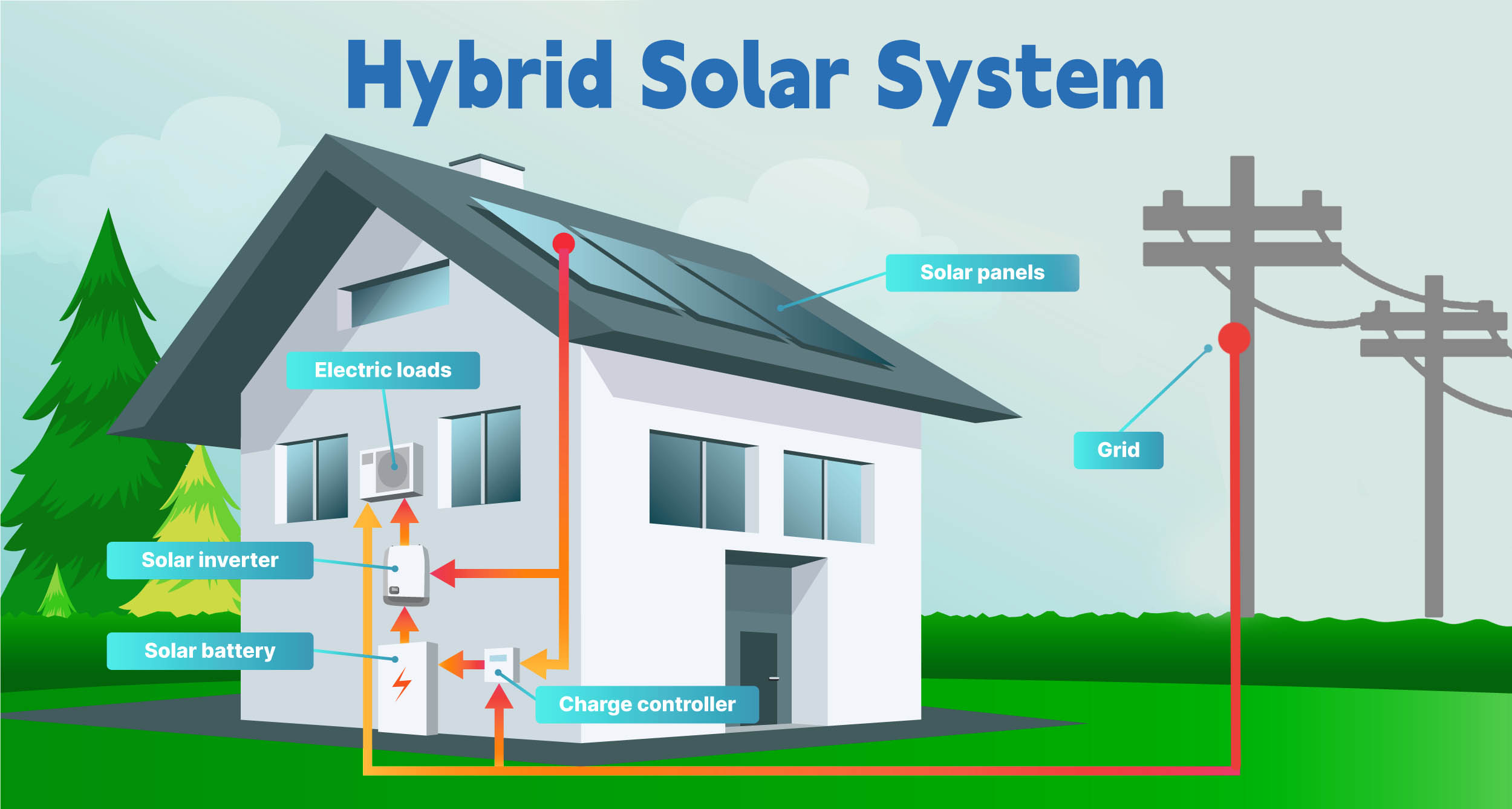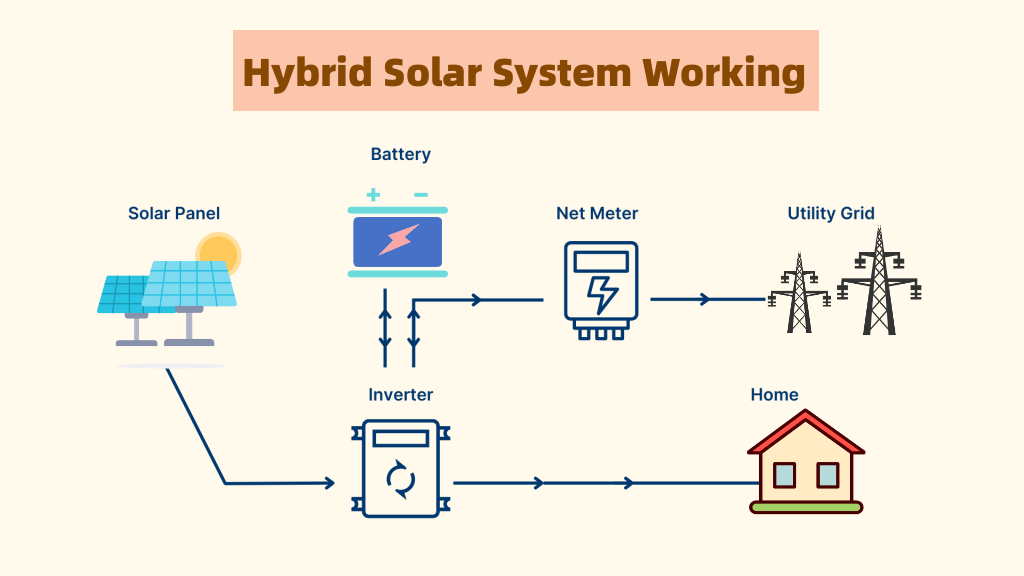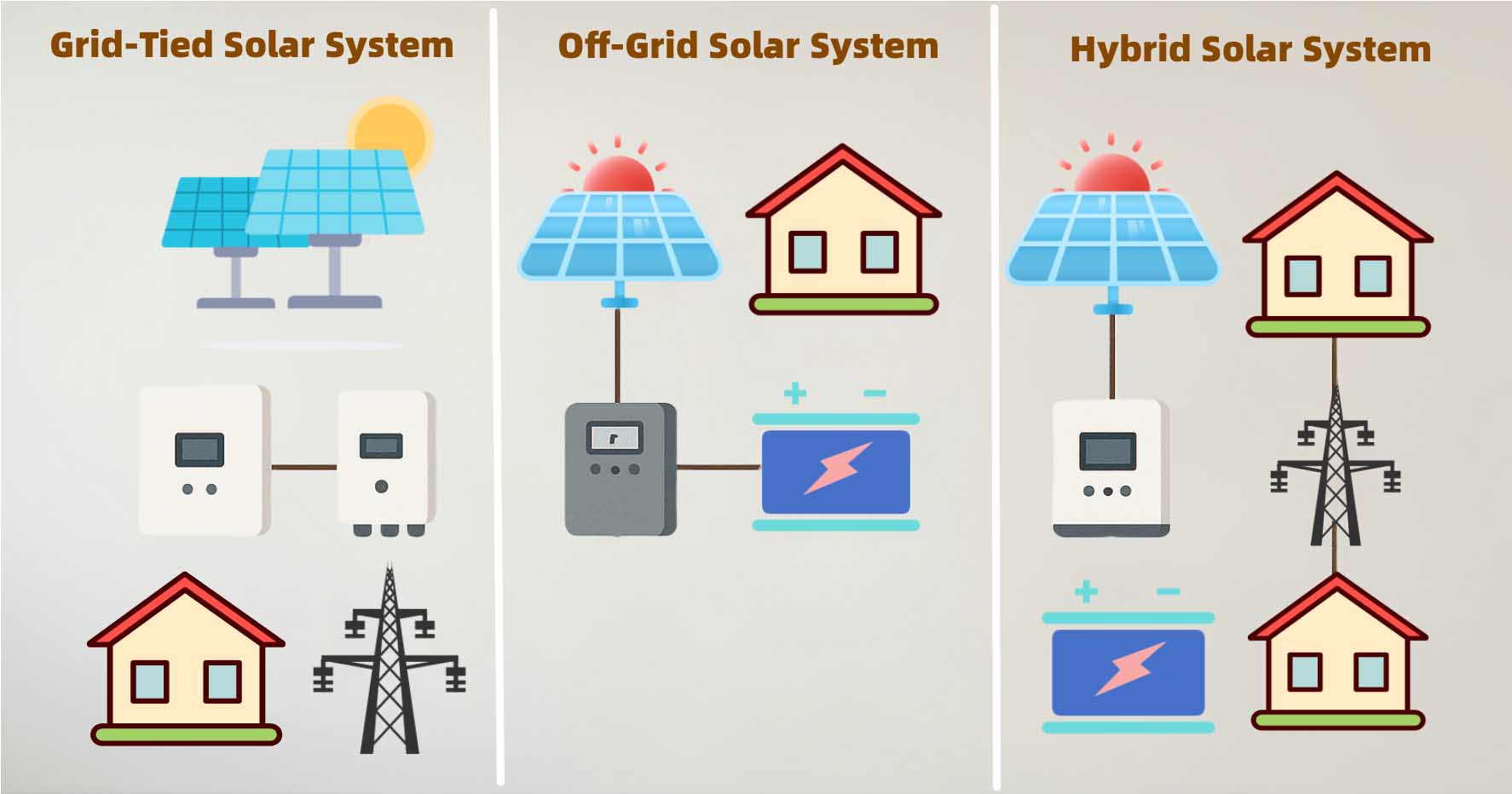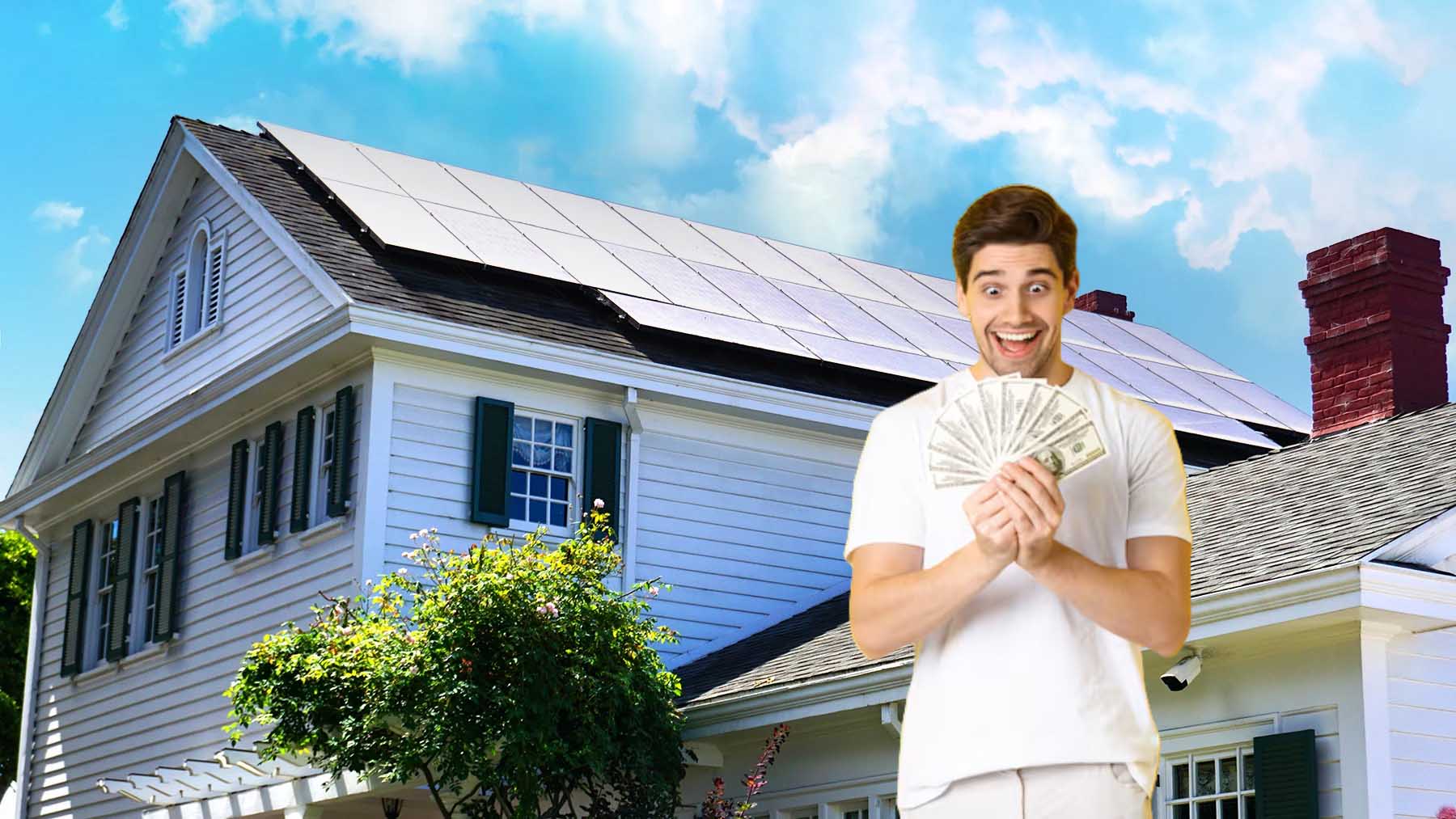
A hybrid solar system is a versatile solar power solution that serves a dual purpose: it can export excess electricity to the national grid while also storing energy in batteries for later use—such as at night, on cloudy days, or during power outages.
By combining the benefits of both grid-tied (on-grid) and off-grid solar systems, it offers one of the most flexible and reliable energy solutions available today for homes and businesses.
1. How Does Hybrid Solar System Work?
The heart of a hybrid solar power system is an intelligent device known as a hybrid inverter (or multiple-mode inverter). It acts as the brain of the system, making real-time decisions about energy flow.
Here's how a typical hybrid solar system works:
① Prioritizes Solar Energy: Solar panels generate DC electricity, which is converted into AC power by the hybrid inverter to power home appliances.
② Charges the Battery: If the solar panels produce more electricity than the home immediately needs, the excess energy is used to charge the battery storage system.
③ Exports Electricity to the Grid: When the battery storage is fully charged and solar production continues, surplus electricity is fed back into the public grid. In many regions, you can receive credits or payments for this energy through net metering or feed-in tariff programs.
④ Uses Battery or Grid Power: When solar generation is low (e.g., at night or on cloudy days), the system first uses stored energy from the batteries.
⑤ Draws from the Grid: If the battery runs low, the system automatically switches to drawing power from the grid to ensure an uninterrupted electricity supply.

Key Feature: Backup Power
Most hybrid solar systems include a critical load panel. During a grid outage, the hybrid inverter automatically disconnects from the grid (a safety measure to protect utility workers) and uses solar panels and batteries to power essential circuits—such as those for refrigerators, lights, and outlets. This is a capability that purely grid-tied systems lack.
2. Key Components Of Hybrid Solar System
A typical hybrid solar panel system includes:
① Solar Panels: Capture sunlight and convert it into DC electricity.
② Hybrid Solar Inverter: The core of the system. Converts DC electricity (from panels and batteries) into AC electricity for home use. It also manages battery charging/discharging and grid interaction.
③ Solar Battery Storage: Stores excess energy for later use. Lithium-ion batteries (e.g., LiFePO4) are commonly used due to their high energy density and long lifespan.
④ Balance of System (BOS): Includes mounting systems, wiring, DC/AC switches, and other electrical components.
⑤ Grid Connection: Connects to the public grid via a meter and service panel.
3. Difference Between On Grid, Off Grid and Hybrid Solar System

| Feature | On-Grid Solar System | Off-Grid Solar System | Hybrid Solar System |
| Grid Connection | Connected to grid | Not connected to grid | Connected to grid |
| Battery Storage | Usually no batteries | Large-capacity battery bank | Includes batteries |
| Power Supply During Outage | No (shuts down for safety) | Yes (fully self-sufficient) | Yes (for critical loads) |
| Excess Power Handling | Feeds back directly to grid | Stored in batteries; excess energy may be wasted. | Charges battery first, then feeds back to grid |
| Cost | Lowest | Highest (requires large battery bank and often a generator.) | Medium (higher than on-grid, lower than off-grid) |
| Suitable For | Areas with stable grid and high electricity rates; fastest ROI | Remote areas without grid access, e.g., mountains, farms | Homes and businesses looking to save on electricity bills with backup power |
4. Advantages & Disadvantages Of Hybrid Solar System
Advantages of Hybrid Solar System
⭐ Energy Independence: Reduces reliance on the grid.
⭐ Backup Power: Provides electricity during outages.
⭐ Maximizes Self-Consumption: Store solar energy for use when the sun isn't shining.
⭐ Cost Savings: Use stored energy during peak rate hours to reduce electricity bills.
⭐ Eco-Friendly: Maximizes the use of clean, renewable energy.

The Disadvantages of Hybrid Solar System
⭐ Higher Upfront Cost: Due to batteries and a more complex inverter.
⭐ System Complexity: Requires professional design and installation.
⭐ Battery Lifespan: Batteries typically last 10–15 years and may need replacement.
5. How Much Does a Hybrid Solar System Cost
A typical home hybrid solar system can cost between $20,000 and $50,000+, depending on:
- ▲ System size (solar panels+ battery capacity)
- ▲ Local incentives and tax credits (e.g., ITC in the U.S.)
- ▲ Installation labor costs
Recommendations:
- >> Get Local Quotes: Prices vary widely. Obtain quotes from 2–3 reputable installers.
- >> Check for Incentives: Look for solar rebates, feed-in tariffs, or battery incentives.
- >> Choose LiFePO4 Batteries: Longer lifespan and better safety.
- >> Define Your Needs: Decide whether backup power or bill savings is your priority.
Installing a hybrid solar system is no small investment. It is essential to make decisions based on local policies and quotations, and give priority to brands and installers with reliable quality and after-sales service.
6. Conclusion

A hybrid solar system offers a triple advantage: energy savings, reliability, and independence. It’s ideal for:
- ✔ Homeowners concerned about power outages
- ✔ Those in areas with high electricity rates or unstable grids
- ✔ Anyone wanting to maximize green energy use
As battery technology improves and costs decline, hybrid solar power systems are becoming an increasingly popular choice.
7. FAQs (Frequently Asked Questions)

Q1: Is a hybrid solar system the same as an on-grid system with a battery?
A1: Essentially, yes. The term hybrid solar system usually refers to a solar system using a hybrid inverter that integrates solar, battery storage, and grid management. While "grid-tied systems with batteries" may sometimes use separate inverters and charge controllers, nowadays, "hybrid systems" has become the common term for such systems.
Q2: Will a hybrid inverter battery system work during a blackout?
A2: Yes, this is one of its core advantages. When the power grid goes down, the system will automatically disconnect from the grid (as required by safety regulations) and switch to "island mode", using solar panels and batteries to continue powering the "critical loads" (such as refrigerators, lighting, routers, etc.) that have been pre-set for the home.
Q3: Does a hybrid solar system require maintenance?
A3: Basically no. The solar panels only need occasional cleaning of dust and debris. The hybrid inverter and lithium batteries are all sealed devices and do not require user maintenance. The system usually comes with a monitoring app, allowing you to check the generation, consumption and storage status at any time.
Q4. Can I use a micro-inverter in a hybrid system?
A4: Yes, but with a specific architecture. Some system designs use a hybrid inverter as the main controller to manage the battery and the grid, while also using micro-inverters with specific functions to optimize the performance of each photovoltaic panel. This requires professional design.
Q5. Can I install batteries on the existing grid-connected system?
A5: Yes, there are two main methods:
① DC coupling: Replace with a hybrid inverter and directly connect the new battery to the new inverter. This is the most efficient method, but it is more costly.
② AC coupling: Keep the original grid-connected inverter and add an additional "AC coupling" battery inverter/charger. This method of renovation is relatively flexible, but the overall efficiency is slightly lower.
Post time: Sep-30-2025

